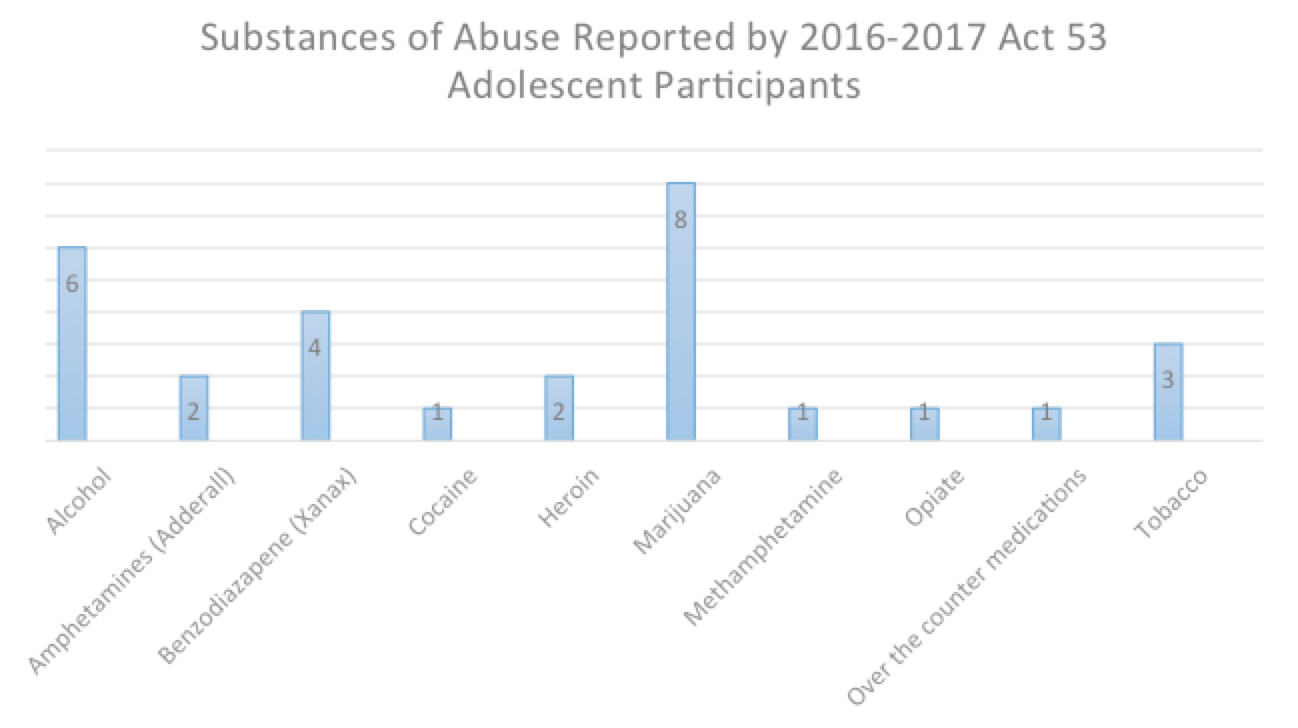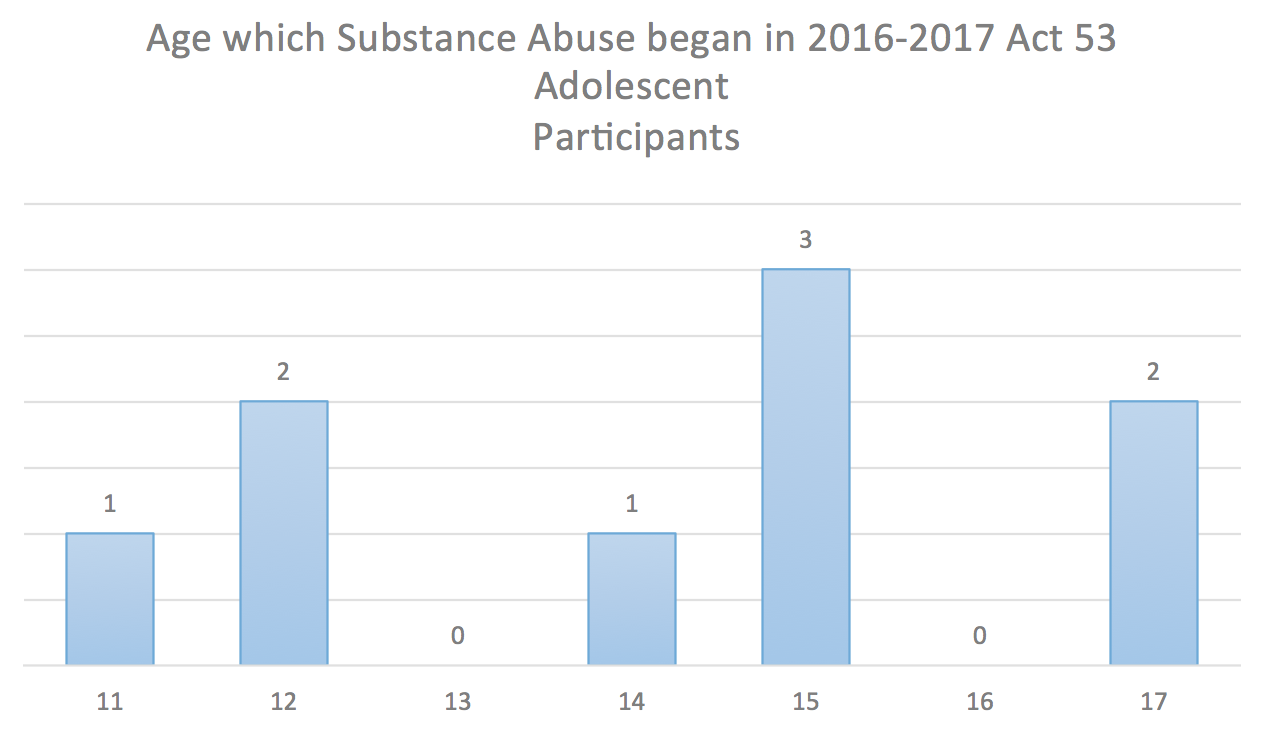Executive Summary
Due to the rise of families and adolescents falling victim to the opiate epidemic as well as in the spirit of reducing barriers to access treatment, in 2016, the Bucks County Drug & Alcohol Commission, Inc. (BCDAC) led an initiative to support families of minors who are using alcohol and other drugs, but who refuse treatment. Key to the process was establishing a collaboration with the Bucks County Office of Children and Youth, Bucks County Court of Common Pleas, Bucks County Sheriff’s Department, Bucks County Clerk of Courts, Bucks County District Attorney and Public Defender, private attorneys, and drug and alcohol providers, to establish a more streamlined approach to assisting guardians interested in filing for involuntary commitment through Act 53, to compel juveniles to enter drug and alcohol treatment. As a result, adolescents are able to access treatment and are mandated to comply with treatment thereby breaking the cycle of addiction.
1997 Act 53 Law
Act 53, the involuntary commitment of minors to drug and alcohol treatment, is a Pennsylvania state law that was passed in 1997. The law ensures that parents or legal guardians can file a petition for a hearing, which may lead to involuntary commitment for drug and alcohol treatment. The law covers minors between the ages of 12 and 17. In 2016, Bucks County’s stakeholders identified a need to change the current Act 53 system including BCDAC, Inc. and Bucks County Children and Youth. They noted a pattern of clients seeking drug and alcohol treatment reporting their drug and alcohol use beginning at the age of nine and older, as well as families with juveniles in active addictions who were concerned about finding their children dead from their substance dependence. Since launching the revamped system in July 2016, Bucks County has had many complicated, scared, and fragile families enter recovery through this revamped system. The previous Act 53 system entailed many weeks in order to obtain the involuntary commitment, and this process was shortened to approximately one week for a parent/guardian to file a petition asking that their child be involuntarily committed to the child receiving treatment.
Referrals
Families connect with our office either through a referral through their school, mental health, or drug and alcohol treatment provider, or have heard about this process through one of our community education forums, social media posts, or hard print media advertisements. Parents or guardians receive information such as how to access treatment, prevention, and intervention services in the county as well as education on the Act 53 process and also an invitation to obtain a free dose of Narcan, the lifesaving medication used to reverse an opiate overdose. During this phone call, the clinical BCDAC, Inc. staff inform parents about the process, what they can expect from following the process, and how to get started. If the parents choose not to file for Act 53, the BCDAC, Inc. staff will continue to follow up with the family to ensure they are able to access recovery supports for themselves and their children. Parents who are calling typically do not know where to turn. They have tried to encourage their child to seek help either through the mental health system, school guidance counselors, or community programming. Often their children are struggling with the disease of addiction and do not see that their substance use is problematic or are not emotionally prepared to seek treatment at the present time. After a family files the appropriate court documentation a court hearing is scheduled and the Bucks County Sheriff’s department serves a court order to the child indicating their presence is required at their scheduled court hearing.
The Act 53 Process
The Act 53 law indicates that the child receives a drug and alcohol assessment which includes a full biopsychosocial and completion of the American Society of Addictions Medicine (ASAM) assessment tool, which determines medical necessity for the appropriate level of care. BCDAC, Inc. arranges for and subsidizes the cost of a drug and alcohol assessment to occur at the Bucks County Courthouse on the same day as the child’s court date with two of our contracted screening and assessment sites. The comprehensive biopsychosocial also includes a parent/ guardian interview, referrals to ancillary services, and a level of care determination. The assessor then presents the results to the child and their legal counsel. If the child agrees to enter treatment willingly the parents are able to stop the process. If the child does not agree with or does not want to participate in the level of care recommended by the assessor the case could go to trial where the parents have to prove that the child is dependent on a substance and their legal right to agree to treatment should be waived and the court should involuntarily commit the child to that level of care. The assessor then coordinates the placement of the child based on drug and alcohol provider availability, location, accessibility, etc. In addition, BCDAC, Inc. has contracted with two local attorneys who have accepted the BCDAC, Inc. case rate in order to represent the minors.
2016-2017 Statistics
In Fiscal Year 2016-2017 BCDAC, Inc. received a total of 30 phone inquiries for information on Act 53. Out of those phone calls, 12 parents filed petitions, two families withdrew their petitions as their children were committed to mental health treatment and sought services through that system. All adolescents were referred to drug and alcohol treatment whose parents filed petitions, two adolescents were sent to inpatient treatment and eight to outpatient levels of care. Referrals to the Act 53 process have come from a variety of stakeholders including Student Assistance Programs, Children and Youth staff, treatment providers, and through word of mouth.
Most of the children are truant and have current or past histories working with Children and Youth, Juvenile Probation, Truancy Court, or have a variety of run-ins with their local police. Most of the parents have been separated or divorced or the children were brought up in single parent homes. About half of the children have someone else in their lives (typically a parent or older sibling) who is in recovery or are in an active addiction. Two of the adolescents reported that their cousins committed suicide which led them to become depressed, later ending in self-medication with substances. Other adolescents reported domestic violence including observing physical abuse between their parents or being victims of abuse by their parents.
Most of the times the parents are able to smell alcohol and marijuana and/ or find paraphernalia that is related to marijuana use, however, often these adolescents are testing positive for other substances during the assessments or treatment stay. The substances that parents and clients have both reported and tested positive for include heroin, marijuana, alcohol, K2, methamphetamine, opiate pills, benzodiazepines, cocaine, synthetic drugs including Suboxone, mushrooms, acid, and Adderall. The concern is that most of these children have progressed from substance abuse to substance dependence by the time their families are aware of the issues that their children are facing.
Cross System Collaboration
Our office has had successful collaboration with many county agencies as well as drug and alcohol providers. To date, our adolescents are compliant with treatment and if they have not been, have had a warm hand off to another county system that can better meet their needs such as Juvenile Probation or Children and Youth. The offices and systems involved have worked diligently during the past year to make changes to the process to streamline it as appropriate for the families to find hope and recovery.
Funding
The funding for treatment relies on the child’s primary medical insurance. Due to the Pennsylvania loophole, adolescent’s do qualify for medical assistance through the loophole, however this process takes time. The Bucks County Drug & Alcohol Commission, through funding from the Pennsylvania Department of Drug and Alcohol Program and other funding, is able to fund the legal counsel and comprehensive drug and alcohol assessment.
Community Implications
By utilizing the Act 53 process, families who have otherwise thought that there was nothing else that could be done to help their loved one find recovery, are able to turn to the courts for assistance. As a result, adolescents are able to access treatment and are mandated to comply with treatment thereby breaking the cycle of addiction. This does mean that more adolescent providers will be needed for all levels of care including both residential and ambulatory. Taking away a person’s rights to indicate whether they want treatment or not is controversial and many families in the midst of living with a loved one with the disease of addiction want a similar proceeding for adults.


Author Bio
Renée M. Calhoun is a licensed Marriage and Family Therapist specializing in addiction. With over 10 years’ experience in the mental health and drug and alcohol field, Renée currently works as the Approval of Care Clinical Supervisor for the Bucks County Drug & Alcohol Commission, Inc.


